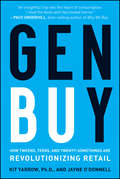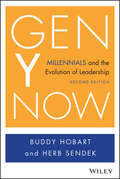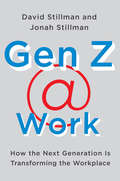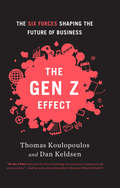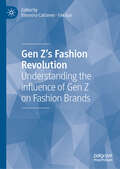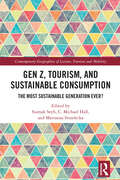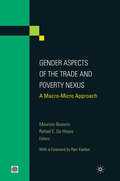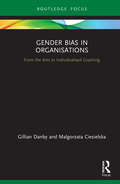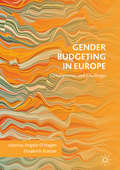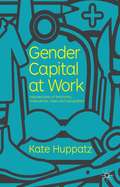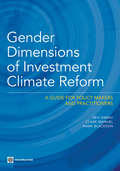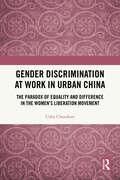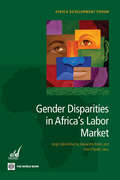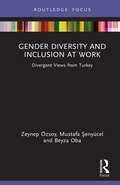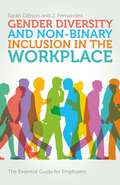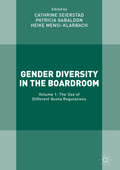- Table View
- List View
Gemba Walks for Service Excellence: The Step-by-Step Guide for Identifying Service Delighters
by Robert PetruskaYour customers have become increasingly sophisticated and more connected than ever—broadcasting real-time feedback to a cloud of followers who are watching your every move. As savvy customers continue to demand more for less, organizations that choose to rest on their laurels will quickly see their market share evaporate.Gemba Walks for Service Excellence: The Step-by-Step Guide for Identifying Service Delighters guides readers on a journey towards organizational effectiveness that supports a culture of service excellence. It provides a fresh perspective on how to apply Gemba Walks—visiting the areas where the service provider interacts directly with the customer—to identify new service delighters and make a lasting positive impression on customers.Using an abundance of color pictures and hand-drawn graphics, Robert Petruska builds on his considerable experience implementing Lean and quality systems to demonstrate how to create the infrastructure required for service excellence to flourish. Presented in an easy-to-follow format that anyone in the service industry can enjoy, this workbook: Shares proven techniques used in Lean manufacturing that can easily be applied to the service industry Guides new employees and veterans alike through a journey filled with real-life stories that inspire confidence Contains hands-on exercises that allow you to immediately apply the ideas to your own work Includes downloadable resources with innovative "placemats" designed to provide stepping stones on a development path for your team to achieve a competitive advantage Filled with real-world examples and stories of service excellence, the book will help you develop the counterintuitive thinking needed to discover new sources of customer delight. Designed to be used with your entire team, this workbook will guide your organization, step by step, through a plan for assessing, prioritizing, and implementing innovative ideas that will lead to unprecedented levels of service excellence.
Gemeinkostenverrechnung und Gemeinkostenmanagement: Unter besonderer Berücksichtigung des öffentlichen Preisrechts (Schriften zu Wirtschaftsprüfung, Steuerlehre und Controlling)
by Sara KranemannAufgrund des gesellschaftlichen Wandels von einer produzierenden Gesellschaft zu einer Dienstleistungsgesellschaft ist der Anteil an Gemeinkosten grundsätzlich steigend. Vor allem im Bereich des öffentlichen Auftragswesens stellen Gemeinkosten im Rahmen der kostenbasierten LSP-Kalkulation den größten Anteil bei der Selbstkostenpreisbildung dar. In der vorliegenden Arbeit werden sowohl theoriebasierte als auch empirische Antworten auf einen preisrechtskonformen Umgang mit Gemeinkosten gegeben. Anhand einer Feldstudie mit 24 Preisrechtsanwendern sowie einer ergänzenden Tiefenfallstudie mit einem Dienstleistungsunternehmen aus dem Bereich des öffentlichen Preisrechts wurden die zuvor gewonnenen theoriebasierten Erkenntnisse mit Einblicken in die betriebliche Praxis gespiegelt. Die Ergebnisse beider Studien zeigen, dass der öffentliche Auftraggeber häufig lenkend in das interne Rechnungswesen seiner Auftragnehmer eingreift. Zudem wird vor allem die Umwidmung von Gemeinkostenbestandteilen zu Einzelkosten als strategisches Instrument genutzt, um deren Abrechenbarkeit gegenüber öffentlichen Auftraggebern und deren Prüfsicherheit im Rahmen der Preisprüfung zu erhöhen. Auf Basis des theoretischen als auch empirischen Erkenntnisgewinns konnten darüber hinaus zahlreiche Implikationen für die unternehmerische Praxis der Preisrechtsanwender gewonnen werden.
Gemeinsam unterschiedlich: Der Leitfaden für Führungskräfte und Mitarbeiter zu Diversity, Integration und Gleichberechtigung am Arbeitsplatz
by Kelly McDonaldUmsetzbare, wirkungsvolle und kostenlose Strategien für mehr Vielfalt und Inklusion am Arbeitsplatz! Rassismus am Arbeitsplatz ist leider keine Seltenheit. Er findet sich in verschiedenen Ausprägungen und Härtegraden. Teilweise ist er sogar unbeabsichtigt, aus Unwissenheit, wie die richtige Verhaltensweise aussehen sollte. Dabei wollen viele Führungskräfte Diversity und Gleichberechtigung stärken. Sie wissen nur oft nicht, wie sie dies angemessen und effektiv tun können. Sie müssen sich über die blinden Flecken bewusst werden, die Hindernisse zum Beispiel für People of Color oder Angehörige von Minderheiten schaffen können. Ihre Absichten mögen aufrichtig und von Herzen kommen, aber Absichten reichen nicht aus. In ihrem Buch liefert die renommierte Rednerin und Bestsellerautorin Kelly McDonald einen dringend benötigten Fahrplan für Geschäftsleute. Dieses Buch wird ihnen dabei helfen, erfolgreich einen fairen und gerechten Arbeitsplatz zu schaffen, der unterschiedliche Talente anerkennt und produktive und konstruktive Gespräche in ihrem Unternehmen fördert. Die Autorin nähert sich dem Thema Diversity nicht aus dem Blickwinkel des sozialen Aktivismus oder aus der Perspektive der Personalabteilung. Stattdessen erläutert sie den Lesern - unabhängig von der Größe ihres Unternehmens - klar und konkret realistisch umsetzbare Lösungen für mehr Fortschritt in puncto Vielfalt und Integration. Führungskräfte, Manager und Geschäftsführer erfahren: - Die Kosten und Risiken, die sie eingehen, wenn es in ihrem Unternehmen an Diversity mangelt. - Wie Menschen, die sich selbst nicht als rassistisch einschätzen, dennoch blinde Flecken in Sachen Vielfalt haben können. - Hinweise zur Gestaltung schwieriger Gespräche, bei denen sie vielleicht nicht wissen, wie sie sie angehen sollen. - Eine Methode, mit der sie sicherstellen können, dass ihre Bemühungen um Diversity, Gleichberechtigung und Inklusion effektiv sind. - Wie sie die Ausreden erkennen, die Menschen benutzen, um Maßnahmen zur Förderung von Diversity und Gleichberechtigung zu vermeiden. - Wie sie, während sie die Vielfalt im Unternehmen voranbringen, die Probleme und Kommentare ansprechen, die auftauchen, wenn sich Mitarbeitende nervös, verärgert oder unwohl fühlen.
Gemeinwohlorientierte Erzeugung von Lebensmitteln: Impulse für eine zukunftsfähige Agrar- und Ernährungswirtschaft
by Albert SundrumLebensmittel sind Mittel zum Leben. Die Art und Weise ihrer Erzeugung betrifft uns alle. Weitgehend unbemerkt von der öffentlichen Wahrnehmung hat sich in den vergangenen Jahrzehnten ein System der Agrar- und Ernährungsindustrie entwickelt, das uns mit einer Fülle von Nahrungsmitteln mit zu niedrigen Preisen versorgt.Die unerwünschten Nebenwirkungen und externen Kosten dieses Systems wurden jedoch lange Zeit ausgeblendet. Enorme Umwelt- und Klimabelastungen, Verlust der Biodiversität, tierschutzrelevante Missstände und ein anhaltendes Hofsterben beschreiben nur unzulänglich das wahre Ausmaß an Schadwirkungen. Im Interesse des Gemeinwohls können diese nicht länger hingenommen werden. Allerdings stehen die Komplexität der Sachverhalte und vielfältige Partikularinteressen einfachen Lösungen entgegen.Dieses Fachbuch liefert eine umfassende systemische Analyse aus sehr unterschiedlichen Perspektiven und erläutert, wie es zu dieser Entwicklung hat kommen können. Es wird aufgezeigt, welche grundlegenden Veränderungen in allen Bereichen erforderlich sind, um über eine evidenzbasierte Qualitätserzeugung einen Ausweg aus dem zerstörerischen Streben nach Kostenminimierung zu finden. Fachkräfte der Agrar- und Ernährungsindustrie und der involvierten wissenschaftlichen Fachdisziplinen, einschließlich der Veterinärmedizin, sowie Entscheidungsträger in politischen Institutionen, Berufsverbänden und NGOs können dieses Wissen für eine zukunftsfähige Neugestaltung des Lebensmittelsektors nutzen.
Gemeinwohlorientierte Unternehmensführung und Transaktionskostentheorie: Theorie und empirische Evidenz
by Johannes ZieglerDie Internationalisierung der Aktionärsstruktur hat den Renditedruck auf Unternehmen erhöht und die Marktwertmaximierung des Eigenkapitals ("Shareholder Value") in den Fokus gerückt. Diese Entwicklung wird von einer Diskussion um die gesellschaftliche Verantwortung von Unternehmen begleitet. Dabei stellt sich die Frage, ob die Shareholder-Value-Maximierung mit dem Gemeinwohl vereinbar ist oder eine Verantwortung gegenüber einer breiteren Stakeholder-Masse besteht. Ziel dieser Dissertation ist es, die Transaktionskostentheorie als ökonomisches Fundament gemeinwohlorientierter Unternehmensführung heranzuziehen. Diese wird als Stakeholder-Ansatz definiert, bei dem die impliziten Ansprüche der Stakeholder – interpretiert als Quasirenten – berücksichtigt werden. Quasirenten resultieren aus unternehmensspezifischen Investitionen und sind aufgrund hoher Transaktionskosten vertraglich nicht vollständig absicherbar. Gemeinwohlorientierte Unternehmen berücksichtigen diese Ansprüche freiwillig in ihren Entscheidungen, was im Vergleich zur reinen Marktwertmaximierung des Eigenkapitals zu einer reduzierten Risikobereitschaft und erhöhten Investitionen in Forschung und Entwicklung führt.
Gemini Investors
by Richard S. Ruback Royce YudkoffGemini Investors was a private equity firm focused on small and lower middle market businesses. Gemini's target investment size was between $4 million and $6 million and a typical portfolio company had revenue of between $8 million and $30 million. In early 2015, Gemini was completing the investment of Gemini's Fund V and it was deciding whether it should raise a fund sized similarly to their prior funds, or alternatively, raising a significantly larger fund.
Gen BuY
by Jayne O'Donnell Kit YarrowDiscover the forces driving the decisions of today's most sought after consumersAccording to recent statistics, members of Generation Y shop 25 percent to 40 percent more than the average consumer. In Gen BuY, Yarrow and O'Donnell argue that these voracious and fearless consumers have revolutionized the way Americans shop by turning traditional sales and marketing strategies upside down. Based on solid research, the book offers an in-depth look at what motivates these young people to buy certain products and reject others. The authors reveal what makes these consumers tic-how they define power, why they loath manipulation, and why they rely on technology-and show marketers how they can tap into the buying power of this burgeoning group of consumers.Shows what it takes to successfully woe and win young consumers with purchasing powerFilled with surprising insights into the psyche of Gen Y buyersWritten by an expert in consumer research and a well-connected media consumer authorGen Buy is a must-have resource for marketers, advertisers, retailers, and manufacturers who want to understand the new generation of consumers.
Gen Y Now: Millennials and the Evolution of Leadership
by Buddy Hobart Herb SendekStrategies for managing the real Generation Y A new generation of workers is forcing employers to rethink the workplace. Generation Y, or Millennials, bring new ideas, innovation, and energy as they enter the workforce AND their expectations and demands are unique. In Gen Y Now, top team leadership gurus Buddy Hobart and Herb Sendek explore all the myths about this up and coming generation and show you how Millennials can be your most creative, motivated, and loyal employees. This book goes from demographic research to concrete practice, explaining that Generation Y is more than we've been led to believe. They value authenticity, flexibility, and recognition. Using the strategies in Gen Y Now, you can hire and retain these demanding workers, and the payoffs could be huge. Keep up with current trends and technologies to move your organization into the future Attract the best young talent in preparation for the mass retirement of Baby Boomers and Gen X Understand how demographic trends impact the way your intergenerational teams think Inspire motivation in Millennial employees, reducing dissatisfaction and turnover costs There are 80 million Millennials, and they are transforming the modern workforce. Your organization stands to gain from Gen Y employee engagement—if you know how to achieve it. Gen Y Now contains the leadership strategies you need to manage and motivate the Millennial generation.
Gen Z Work: How the Next Generation Is Transforming the Workplace
by David Stillman Jonah StillmanA generations expert and author of When Generations Collide and The M-Factor teams up with his seventeen-year-old son to introduce the next influential demographic group to join the workforce—Generation Z—in this essential study, the first on the subject.They were born between between 1995 and 2012. At 72.8 million strong, Gen Z is about to make its presence known in the workplace in a major way—and employers need to understand the differences that set them apart. They’re radically different than the Millennials, and yet no one seems to be talking about them—until now. This generation has an entirely unique perspective on careers and how to succeed in the workforce.Based on the first national studies of Gen Z’s workplace attitudes; interviews with hundreds of CEOs, celebrities, and thought leaders on generational issues; cutting-edge case studies; and insights from Gen Zers themselves, Gen Z @ Work offers the knowledge today’s leaders need to get ahead of the next gaps in the workplace and how best to recruit, retain, motivate, and manage Gen Zers. Ahead of the curve, Gen Z @ Work is the first comprehensive, serious look at what the next generation of workers looks like, and what that means for the rest of us.
Gen Z Effect: The Six Forces Shaping the Future of Business
by Dan Keldsen Tom KoulopoulosOne of the most profound changes in business and society is the emergence of the post-Millennial generation, Gen Z. While every new generation has faced its share of disruption in technology, economics, politics and society, no other generation in the history of mankind has had the ability to connect every human being on the planet to each other and in the process to provide the opportunity for each person to be fully educated, socially and economically engaged. What might this mean for business, markets, and educational institutions in the future? In this revolutionary new book, The Gen Z Effect: The Six Forces Shaping the Future of Business, authors Tom Koulopoulos and Dan Keldsen delve into a vision of the future where disruptive invention and reinvention is the acknowledged norm, touching almost every aspect of how we work, live and play. From radical new approaches to marketing and manufacturing to the potential obliteration of intellectual property and the shift to mass innovation, to the decimation of our oldest learning institutions through open source and adaptive learning, The Gen Z Effect provides a mind-bending view of why we will need to embrace Gen Z as the last, best hope for taking on the world's biggest challenges and opportunities, and how you can prepare yourself and your business for the greatest era of disruption, prosperity, and progress the world has ever experienced.
Gen Z in Work: A Practical Guide to Engaging Employees Across the Generations
by Karina OchisThis concise and clear book provides actionable solutions to every manager’s and leader’s newest problem: How to work effectively with Gen Z employees.Employee disengagement is a problem for businesses around the globe, with 85% of employees actively disengaged from their work. By 2025, Gen Z will account for one-third of the workforce, according to the World Economic Forum, and a growing challenge is how to adapt organizations to effectively include this group. Companies must now redesign long-established practices to include rapid integration, gamified rewards, mixed generation teams, and multigeneration training in ways that will capitalize on the current behaviors of Gen Z, as well as other worker groups.This book provides: The measures companies can take to forge productive relationships between Gen Z and older, more experienced employees. An approach that can be readily applied by senior executives and managers to engage Gen Z employees and to address the disengagement problem more broadly. Implementable solutions on how five traditional practices – onboarding, leadership, culture, motivation, and benefits – can be altered in companies to improve Gen Z productivity. The problem of disengagement is widespread across companies and industries and results in diminished productivity, high turnover costs, and the loss of experienced professionals. Managers and leaders across all sectors will find this book indispensable in implementing an actionable strategy for improving the performance of Gen Z.
Gen Z's Fashion Revolution: Understanding the influence of Gen Z on Fashion Brands
by Yan Sun Eleonora CattaneoThis book explores the significant changes that the fashion industry is undergoing as a result of the powerful influence of Gen Z - a demographic that demands authenticity, diversity, and sustainability from the brands they interact with. Understanding and catering to the interests of Gen Z is vital for fashion brands who want to remain competitive, build brand loyalty, and secure future success. Looking at the global market segment, with additional analysis of local differences across regional markets, the authors focus on the intersection of youth culture, digital innovation, and the transformation of the fashion industry. The chapters capture the unique spirit and influence of Gen Z, showcasing their role as trendsetters who are revolutionizing traditional fashion norms and shaping the future of style. By exploring the dynamic relationship between Gen Z and fashion, this book offers a fresh and insightful perspective, covering topics such as Gen Z and luxury, the rise of the fashion metaverse, influencers, and inclusivity.
Gen Z, Tourism, and Sustainable Consumption: The Most Sustainable Generation Ever? (Contemporary Geographies of Leisure, Tourism and Mobility)
by C. Michael Hall Siamak Seyfi Marianna StrzeleckaGen Z, Tourism, and Sustainable Consumption is the first book to provide a comprehensive account of Generation Z in relation to sustainable consumption practices and travel cultures. Gen Z is regarded as the world’s largest consumer market. The growth and behaviour of this economically significant market will have enormous implications for the future development of the tourism industry and destinations and its long-term sustainability. Characterised as being the first generation to grow up with the Internet and sometimes even referred to as the i-Generation, Gen Z is broadly regarded as having an avid interest in travel but seeks to do so in a way that is socially and environmentally conscious, mobile connected, and grounded in authentic local experiences. Logically structured and featuring contributions from a plethora of experts on the topic, this volume provides a critical examination of Gen Z consumer and travel behaviour in a comparative international context and its implications for the tourism, hospitality, and events industries. Embellished with illustrative figures and tables throughout, this book will be of pivotal interest not only to policy makers, destination management and marketing organisations (DMOs), and students of tourism, hospitality, sustainable consumption, and consumer culture, but also to those who seek to cater to this key market.
GenapSys: Business Models for the Genome
by Joseph Fuller Matthew Preble Richard G. HamermeshGenapSys, a California-based startup, was soon to release a new DNA sequencer that the company's founder, Hesaam Esfandyarpour, believed was truly revolutionary. The sequencer would be substantially less expensive-potentially costing just a few thousand dollars-and smaller than other sequencers, many of which were large devices costing tens of thousands or hundreds of thousands of dollars. GenapSys' device, named GENIUS, could also quickly generate large amounts of data, as it was capable of sequencing an entire human genome in less than eight hours. At this price, GenapSys' device would be attractive to customers that had been unable to afford sequencers, such as smaller laboratories or hospitals, and even expand the market to include industries such as agriculture and biofuels. As GenapSys came closer to releasing its product, Esfandyarpour and his Senior Director of Operations and Strategy, Leila Rastegar (HBS '11), sat down to decide which of three business models they would choose to bring this device to market. In the first model, the company would sell sequencers at a higher price to those entities which already purchased sequencers, primarily major research labs and pharmaceutical firms, but position its machine as a faster alternative to existing technologies. In the second model, GenapSys would sell its sequencer at a lower price but charge more for the cartridges necessary to run a sample, and earn its primary revenue from these cartridges. The third model would see GenapSys sell its device at or around cost, but use the data customers generated to create a proprietary database of genetic information. Customers could pay to access the database for research, to create genetic tests, or for many other purposes. GenapSys would also build an online store with the genetic tests customers created. Esfandyarpour's and Rastegar's decision would determine GenapSys' customer base and financial position for the coming years, and also impact develop
Gender Aspects of the Trade and Poverty Nexus
by Maurizio Bussolo Rafael E. De Hoyos Ravi KanburTrade liberalization can create economic opportunities for poor people. But are these opportunities available to men and women equally? Do the gender disparities in access to education, health, credit, and other resources limit the gains from trade and the potential benefits to poor women? This volume introduces the gender dimension into empirical analyses of the links between trade and poverty, which can improve policy making. The collection of chapters in this book is close to an ideal macro-micro evaluation technique that explicitly assesses the importance of gender in determining the poverty effects of trade shocks. Part I, relying on ex ante simulation approaches, focuses on the macroeconomic links between trade and gender, where labor market structure and its functioning play a key role. Part II concentrates on micro models of households and attempts to identify the ex post effects of trade shocks on household income levels and consumption choices. It also addresses questions about possible changes in inequality within households due to improved economic opportunities for women. 'Gender Aspects of the Trade and Poverty Nexus' will be invaluable to policy makers, development practitioners and researchers, journalists, and students.
Gender Bias in Organisations: From the Arts to Individualised Coaching (Routledge Focus on Business and Management)
by Malgorzata Ciesielska Gillian DanbyGovernment and organisational policies are not enough to challenge socially constructed expectations towards gender. Arts based methods derived from sensemaking, metaphors and storytelling can support women in modifying behaviours triggered by gender stereotype threat and help them cope better in the gendered workplace. The aim of the book is to challenge the contemporary approach of mainstreaming gender in organisations. Starting with individuals’ life stories and workplace experiences to understand the common challenges for individuals and organisations, the authors review how women respond to those challenges through strategic choice, and consequences both for the individual and the organisational impact. This book presents two types of arts inspired workshops: sensory and metaphorical engagement as well as storytelling theatre. Gender Bias in Organisations: From the Arts to Individualised Coaching discusses how gender mainstreaming initiatives have failed and proposes an individualised coaching approach based on arts-based methodology for mediating gender stereotype in the workplace. It will be of interest to researchers, academics, and students in the areas of gender, work and organisation.
Gender Budgeting in Europe: Developments And Progress
by Angela O'Hagan Elisabeth KlatzerThis book takes a broad look at conceptual and practical applications of gender budgeting in Europe. It comprises three linked sections that work through conceptual definitions of gender budget analysis. These sections explore how it can be framed and constructed as a gender equality policy; investigate case studies across Europe; and examine challenges for implementation. The first book of its kind, Gender Budgeting in Europe explores conceptual and methodological variations evidence in practice in Europe and the challenges of adoption and implementation in different political and institutional contexts. It brings together historical and current conceptual developments and tensions; approaches, methodologies, and tools in practice across Europe; activism, actors and agency and the engagement of formal institutions at all levels of government with feminist policy changes and feminist analysis and activists. This text is fascinating reading for students, scholars, policy makers and activists.
Gender Capital at Work
by Kate HuppatzDrawing on interviews with nurses, social workers, exotic dancers and hairdressers, this book explores the processes involved in producing and reproducing gendered and classed workers and occupations.
Gender Differences in Managerial Behavior: The Ongoing Debate
by Herminia Ibarra Kristin M. DalyDo men and women have distinct leadership styles? Do they approach management differently? This note summarizes the two perspectives that have dominated the ongoing debate on gender differences in organizational leadership and management behavior. Psychological theories emphasize the different outlook, attitudes, and values inculcated in men and women during their development and socialization. In contrast, situational theories argue that gender differences are few, and largely an artifact of differences in opportunity, power, and lack of representation in business and organizational settings. The evidence from research studies is reviewed briefly.
Gender Dimensions of Investment Climate Reform: A Guide for Policy Makers and Practitioners
by Sevi Simavi Clare Manuel C. Mark BlackdenThe economic empowerment of women is increasingly seen as one of the most important forces behind economic growth and the fight against poverty. Indeed, women's economic participation in an economy as entrepreneurs, employees, and leaders is recognized as a measure of a country's dynamism and viability. 'Gender Dimensions of Investment Climate Reform' provides fresh solutions to common issues that women entrepreneurs face. It presents actionable, replicable, and scalable tools for promoting gender-sensitive investment climate reforms that would benefit both women and men. The book enables development practitioners and policy makers who are not gender specialists to diagnose gender issues in an investment climate; design creative and practical solutions and recommendations for addressing gender constraints; and monitor and evaluate the implementation of those recommendations.
Gender Discrimination at Work in Urban China: The Paradox of Equality and Difference in the Women's Liberation Movement
by Usha ChandranThis book explores gender discrimination and women’s movements in China – from the May Fourth movement to present day. It critically examines the dynamics of the personal and political, or ‘home’ and ‘work’, and the role this discourse plays in women’s lives.The book looks at women's 'work' within the contested field of a gender power struggle both in the politics and society in China. Patterns of employment for women have evolved over the years and women have continued to face new challenges at home and outside as the boundaries between the political and personal blurs. This book analyses the birth of feminism in China, its amalgamation with Marxism to take the form of the women's liberation movement propagated by the party and state and its impact on shaping contemporary Chinese women. It also discusses the theoretical and practical trajectory of women's liberation movement and the changing ideas on women and gender in contemporary China.The book will be of interest to students and researchers of gender studies, political sociology, Chinese studies, sociology of work and industry, history of women's work in China, labour history, gender inequality and discrimination in the workplace in China.
Gender Disparities in Africa's Labor Market
by Jorge Saba Arbache Alexandre Kolev Ewa FilipiakWomen's earnings are a fraction of male's earnings in several African countries. It is tempting to conclude that this wage gap is a sign of discrimination against women in the labor market. Yet this book uses new datasets to show that the gap is not simply the result of discrimination in the labor markets, but rather the result of multiple factors, including access to education and credit, cultural values and household duties, and, above all, labor market conditions. It shows that gender disparities grow when economies are not functioning well and labor markets are tiny. More than the effect of discrimination, it seems that job rationing causes those with better human capital and those with more power in the household-usually the men-to take the few jobs that are available. It is hardly surprising, then, that in a region where only a fraction of the labor force finds jobs in the formal sector, gender disparities in earnings are so high. The book further documents that firm-level and sector characteristics are additional powerful factors in explaining the gender disparities in the labor market. As the causes are not simple, neither are the solutions; multifaceted strategies are needed. By providing environments that support economic growth and, more importantly, job creation, as well as by promoting equal access for women to education and rethinking the attitudes that limit what women may achieve, governments in the region will substantially improve the well-being of all their peoples. 'Gender Disparities in Africa's Labor Market' helps to fill the knowledge gap and identify the links between gender disparities and poverty reduction. The work was implemented in collaboration with a range of poverty and labor market studies to maximize its usefulness for policy dialogue in specific countries. This book will be of interest to policy makers, students, academics, gender experts, and all those interested in gender issues and development.
Gender Diversity and Inclusion at Work: Divergent Views from Turkey (Routledge Focus on Business and Management)
by Zeynep Özsoy Mustafa Şenyücel Beyza ObaThe purpose of this book is to investigate gender diversity practices and discourse developed by listed companies in Turkey. It pursues this aim by advancing knowledge about business relations affecting workplace gender diversity. The research builds on Bourdieu’s field approach and implements a Thematic Analysis following Braun and Clarke’s (2006) guidelines. The findings of the book are based on data collected from unstructured interviews and secondary sources such as the official documents of national and international organizations, newspapers, legislation, and web pages of the related parties. The findings suggest that the implementation of gender diversity practices may require a transformation of perspective and the conditions regarding the political, economic, and cultural realm for realization of a pervasive movement. Due to the conservative and patriarchal culture, authoritarian rule and neoliberal policies, gender diversity and inclusion are not seen as issues that should be resolved through the commitment and collaboration of a field. Consequently, diversity management practices are instrumentalized by the business community as a means for corporate communication and image building rather than actively building a diverse workforce.
Gender Diversity and Non-Binary Inclusion in the Workplace: The Essential Guide for Employers
by Sarah Gibson J. FernandezHelping to create inclusive work environments for non-binary people, this book builds knowledge of non-binary identities and provides practical solutions to many of the basic workplace problems this group face. Working with and including non-binary people in the workplace is beneficial for both employer and employee, as it attracts and retains younger and non-binary workers by helping promote an inclusive brand, as well as satisfying equality obligations. Based on novel research of non-binary inclusion within businesses, it provides a basic overview of non-binary people, a business case for inclusion, a brief description of how non-binary people fit into current equality laws and likely future developments in the area. An ideal introduction for companies wishing to embrace all genders in the workplace.
Gender Diversity in the Boardroom
by Cathrine Seierstad Patricia Gabaldon Heike Mensi-KlarbachThis edited collection provides a structured and in-depth analysis of the current use of multiple approaches beyond quotas for resolving the pressing issue of gender inequality, and the lack of female representation on corporate boards. Filling the gap in existing literature on this topic, the two volumes of Gender Diversity in the Boardroom offers systematic overviews of current debates surrounding the optimisation of gender diversity, and the suggested pathways for progress. Focusing on sixteen European countries, the skilled contributors explore the current situation in relation to women on boards debates and approaches taken. They include detailed reflections from critical stakeholders, such as politicians, practitioners and policy-makers. Volume 2 focuses on eight European countries having multiple approaches beyond quotas and is a promising and highly valuable resource for academics, practitioners, policy makers and anyone interested in gender diversity because it examines and critiques the current corporate governance system and national strategies for increasing the share of women not only on boards, but within companies beyond the boardroom.






